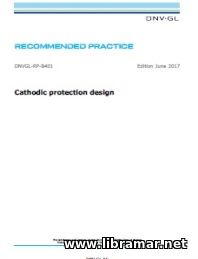 The recommended practice related to the design of the cathodic protection, prepared by DNV GL professionals. Traditionally for all DNV GL guidelines, the document opens with the general information part explaining the very basics of the cathodic protection principle, scope of this paper, its objectives and use, its structure and relation to other documents.
The second chapter lists the references, such as the ASTM, EN and ISO standards, and another DNV GL document governing the CP of submarine pipelines by galvanic anodes. Then there is a list of abbreviations, terms, symbols and definitions used in the document. The main part of the paper addresses the general considerations for the design of cathodic protection, main design parameters to consider, design procedures and associated calculations, manufacture of the anodes and their installation.
There are three appendices at the end, first of them contains informative data tables and figures to supplement main text, while the other two provide the results of the laboratory tests of the galvanic anode materials for quality control and for electrochemical performance qualification. Noting the amount of useful technical information contained in the volume and that it has been released by the authoritative entity, we highly recommend it for familiarization to all parties involved in provision of CP.
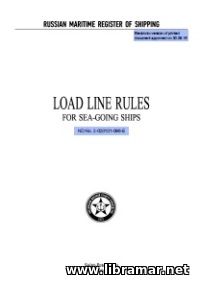 The Russian Register's Load Line Rules for Sea-Going Ships, the latest release. The main content of this rulebook is arranged in eight major chapters. The opening chapter provides some general information about the document, the definitions of the main terms, surveys and certificates, navigational areas etc.
The second chapter is devoted to the load line markings commonly in place on the vessels involved in international voyages, while the third chapter provides conditions of freeboard assignment for such ships. The remaining chapters of the document deal with the minimum freeboard assignment, MODU load line markings, special requirements applicable to the vessels assigned timber freeboards and to the vessels of smaller size (i.e. less than 24 meters).
The appendix providing the information about the zones, areas and seasonal periods is closing the document. Needless to say that the rulebook, apart from being a must-have one for the inspectors of Russian Register, is recommended to be possessed on board any RS-classed vessel so that the crew members can be well aware about its content and maintain their vessel accordingly and in full compliance with the requirements.
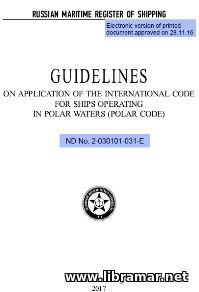 These Guidelines were approved following the established approval procedure and are in force from January 2017. They were developed on the basis of the provisions of the Polar Code adopted by MSC.385(94) and MSC.264(68). The Guidelines shall be used by the class surveyors performing surveys of the vessel's compliance with the Polar Code, as well as by the ship owners and crew members to keep the vessel compliant and prepare for the class inspection.
The content is arranged in two parts. The first part gives some general information including scope of application and definitions used throughout the text of the Polar Code and of these Guidelines. The second part contains technical requirements covering the structure, subdivision and stability of the vessel, technical supervision requirements, fire protection and lifesaving arrangements on board, weather- and watertightness of the hull, communication equipment, operational assessment, shipboard machinery installations, measures for preventing pollution, safety of navigation and other important aspects up to the documentation, both operating and technical. The document shall be possessed on board any RS-classed vessel engaged in the voyages in the Polar waters.
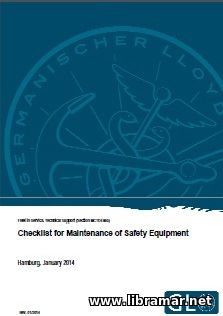 Here is a brief but thorough overview by Germanischer Lloyd's specialists which was compiled with their intention to provide industry with the recommendations and applicable requirements for the inspection and periodical maintenance of the safety equipment on board vessels - it is to be used as a practical and compact tool for marine surveyors, ship owners, operators and any other involved parties.
The present GL document covers such an important ship safety aspects as fire protection and fire fighting arrangements, fixed fire extinguishing systems on vessels, life-saving appliances, navigational and radio equipment, etc. According to the general rule, all shipboard inspections must be performed in full accordance with the instructions that are usually provided by the systems manufacturer, taking into account all safety precautions. If the safety equipment is currently under maintenance or being tested, then suitable safety arrangements must be in place there to ensure that the safety of the ship has not been affected in any way - this can be done using the alternative equipment, for example, or by other measures.
All associated inspection records must be kept on board the vessel; alternatively, they may be computer-based. If the inspections are performed by specially trained persons and not by crew members, the reports must be provided upon completion of all relevant inspections...
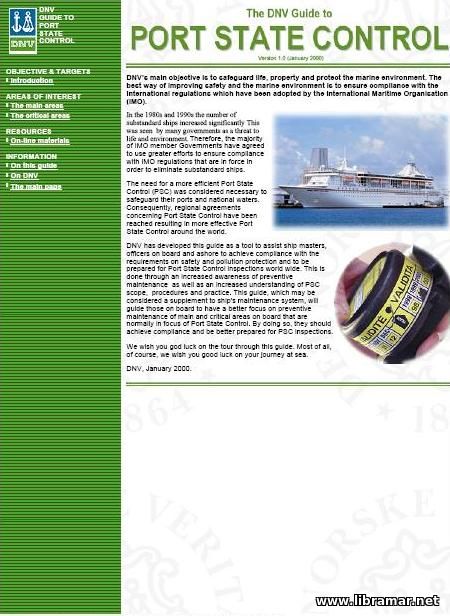 As the industry professionals, we are for sure aware of the fact that the number of substandard vessels significantly increased in the period 1980-1990. This was seen by all governments as a serious threat to the life at sea as well as to the marine environment.
As a result, most of the IMO members came to the right decision to use even greater efforts in order to ensure due compliance with the regulations developed by the IMO making a good attempt to reduce the number of such substandard vessels. DNV, one of the world's leaders in providing classification services, developed the present Guide which can be used as a very informative and useful tool by ship masters, crew members and officers both ashore and on board to achieve required compliance with the requirements covering the safety of life at sea and protection of the environment - it is actually an invaluable instrument for preparation for the PSC inspection.
It may be treated as a good supplement to the maintenance system established on the ship, and will direct people on board to better focus on the maintenance of the critical areas that are usually in focus of PSC. By doing so, they shall be able to better prepare their ship for the forthcoming visit of the PSC inspector and avoid any problems.
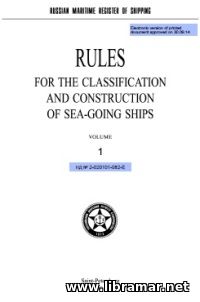 The RMRS Rules, the electronic version of printed document. The present set of Rules consists of three major volumes. The Rules developed and released by Russian Register cover all important aspects of classification, vessel hull, equipment and outfitting, subdivision and stability issues, fire protection arrangements, boilers and pressure vessels plus heat exchangers, requirements to apply to the materials and welding, ship hull systems and piping, ship electrics, electronics and automation, refrigerating plants, structural requirements and strength of glass-reinforced plastic boats and vessels, instructions on the abbreviation expansion for the marks and classification notations specifying operational/structural particulars of ships.
The present release of the Rules is considering all latest amendments that have been developed straight before its publication. The IACS UR, UI and recommendations have also been taken into account, together with all relevant IMO resolution. Needless to say that this set of Rules will be critically necessary for the crew members of any vessel classed with the Russian Register to make sure that their vessel complies with all applicable requirements and also to get prepared for the forthcoming visit of the class inspector for the required periodical or any other inspection.
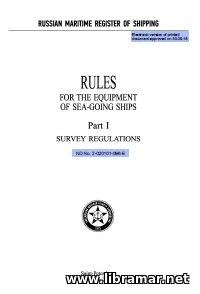 The latest release of the Russian Register Rules covering the equipment installed on board sea-going vessels. The content of the Rules has been arranged in five separate volumes. The first volume is the smallest - it provides the general survey regulations including survey periods, application of particular requirements, plan approval, technical documentation and other matters considered to be of general nature.
The second Rulebook of the set is devoted to the lifesaving appliances and provides relevant requirements to the LSA of the passenger, cargo, and other types of ships as well as the general requirements to the lifesaving appliances and arrangements on board. The third book covers the means of signaling including the lists of signaling equipment, their construction and fitting of the signal means on board - note that there are additional requirements applicable to the river-going vessels.
Finally, the last two volumes provide the requirements applicable to the radio and navigational equipment installed on board sea-going vessels including functional requirements, performance standards, installation aspects etc. A must-have publication to be possessed on board any sea-going vessel classed by the Russian Register of Shipping.
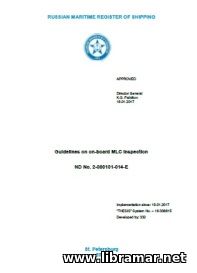 These officially published Russian Register Guidelines are defining the procedure for compliance of the on-board living and working conditions for the seafarers with the applicable requirements of MLC 2006 Convention, with particular emphasis being placed on the national legislation.
The document is intended to determine the procedure for the issuance of the MLC Certificate to a vessel fully compliant with the requirements of the Convention, and procedures to be followed when performing the review and certification of Part II in the Declaration, as per the MLC Regulation 5.1.3.
The document shall be used by the Russian Register personnel engaged in the relevant inspections as well as by the crew members preparing their vessel for the inspection by RS to ensure compliance with all relevant requirements prior to the inspector's visit on board, again taking into account the national laws and regulations governing the living and working conditions and arrangements.
The document starts with the scope of application and documents, followed by the guidelines for the inspectors and procedures to be followed in the course of the inspection. Three appendices supplement the main content of the Guide with additional information.
« 1 2 3 4 5 6 7 ... 29 30 » |







